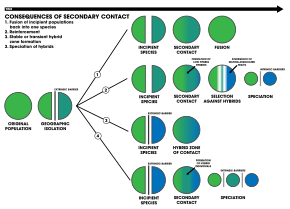
1. An extrinsic barrier separates a species population into two but they come into contact before reproductive isolation is sufficient to result in speciation. The two populations fuse back into one species
2. Speciation by reinforcement
3. Two separated populations stay genetically distinct while hybrid swarms form in the zone of contact
4. Genome recombination results in speciation of the two populations, with an additional hybrid species. All three species are separated by intrinsic reproductive barriers[1]
Secondary contact is the process in which two allopatricaly distributed populations of a species are geographically reunited. This contact allows for the potential for the exchange of genes, dependent on how reproductively isolated the two populations have become. There are several primary outcomes of secondary contact: extinction of one species, fusion of the two populations back into one, reinforcement, the formation of a hybrid zone, and the formation of a new species through hybrid speciation.[1]
- ^ a b John A. Hvala and Troy E. Wood (2012). "Speciation: Introduction". Encyclopedia of Life Sciences. doi:10.1002/9780470015902.a0001709.pub3. ISBN 978-0470016176.
{{cite book}}:|journal=ignored (help)
